This website uses cookies so that we can provide you with the best user experience possible. Cookie information is stored in your browser and performs functions such as recognising you when you return to our website and helping our team to understand which sections of the website you find most interesting and useful.
On 23 November 2022, during WorldGBC APN award ceremony at Bali, Indonesia, WorldGBC thanked AGC for being the founding partner of Asia Pacific Network.

WorldGBC goals and AGC’s social value creation
Buildings are responsible for 39% of global energy-related carbon emissions, of which 28% are from operational emissions such as heating, cooling, and powering our buildings and appliances. The remaining 11% are from the materials manufacturing and the building construction processes. Accordingly, any plans to effectively tackle climate change must include addressing the built environment. Against this pressing need, the World Green Building Council’s (WorldGBC) role is to catalyse the uptake of sustainable built environments for everyone, everywhere.
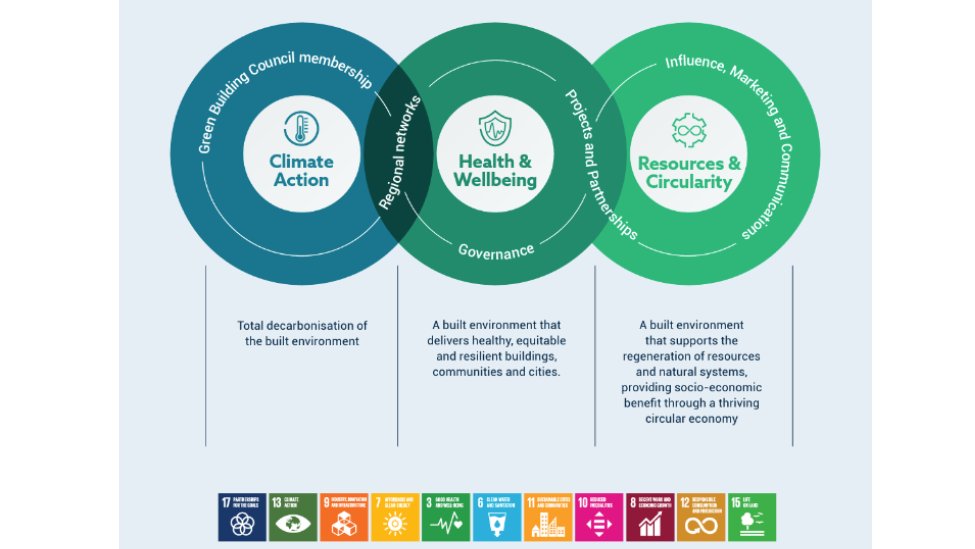
The WorldGBC works in three strategic areas which collectively organise and lead the industry towards a net-zero carbon, healthy, equitable and resilient built environment. The strategic areas are climate action, health & wellbeing, and resource & circularity. Climate action efforts are fronted by the Advancing Net Zero Program. The goal of the program is the total decarbonisation of the built environment. The WorldGBC’s Health and Wellbeing Framework is a tool to deliver healthy, equitable and resilient buildings, communities, and cities. Resource & Circularity is advanced by the WorldGBC’s Circularity Accelerator. Through awareness, advocacy and industry engagement, the accelerator works to realise a built environment that supports the regeneration of resources and natural systems, providing socio-economic benefit through a thriving circular economy. The accelerator’s 2030 goal is the sustainable management and efficient use of natural resources within the built environment, achieving zero-waste-to-landfill targets and working towards a built environment with net zero whole-life resource depletion.
As the saying goes, “if you want to go far, go together.” The WorldGBC Global Network supports the transformation of the building and construction sector. Through this network, WorldGBC works with businesses, organisations, and governments to drive the Paris Agreement targets and UN Sustainable Development Goals (SDGs). In the Asia Pacific Regional Network (APN), AGC Asia Pacific has been a regional partner since 2017, collaborating with fifteen regional GBCs to organise, coordinate and support APN’s efforts in all strategic areas.
With more than a century’s worth of experience in materials manufacturing, AGC’s role as an APN Founding Partner is an apt one. Besides the environmental footprint of the manufacturing process, the usage of materials has a far longer and wider impact. Over the decades, AGC provided a wide range of glass, electronics, chemicals, and ceramics products which can be found in vehicles, buildings, medical services, agriculture, and in many other unique solutions. In essence, AGC’s products are an essential part of people’s lives globally. To continue to thrive for over a century, the company must constantly innovate and keep moving forward. In their latest transformation, AGC has adopted sustainability management, an approach that focuses on both economic and social value. The move stems from the recognition that economic performance is inextricably woven into the environment and social fabric in which the business activities are situated. Thus, AGC’s social value creation approach reflects the group’s careful analysis of long-term social trends. This yielded corresponding sustainability management policies and strategies which seek to capture future opportunities while mitigating risk. This approach secures AGC’s economic performance by creating win-win situations with all stakeholders, including the society at large and the natural environment.

To realise sustainability management, AGC wants to create five types of social value through the company’s products, technologies, and activities. Social value is generated by (1) contributing to the realisation of a sustainable global environment, (2) contributing to the realisation of safe and comfortable urban infrastructure, (3) contributing to the realisation of safe and healthy lifestyles, (4) contributing to the maintenance of a healthy and secure society and (5) contributing to the creation of fair and safe workplaces. AGC’s value creation model reflects WorldGBC’s strategic impact areas and more. Climate action and resource and circularity are congruent with the realisation of a sustainable global environment while a lifecycle perspective to health and wellbeing corresponds to safe, healthy, fair, and secure lifestyles, workplaces, and society. To advance the sector through collaboration, this article aims to share AGC’s knowledge and experience, allowing others to build upon it and together create best practices and mindsets.
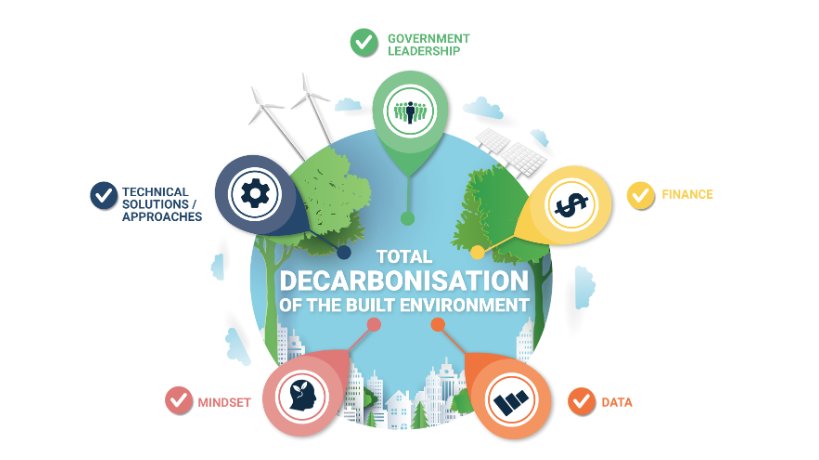
The principles of advancing net zero
When exploring corporate activity for climate action, WorldGBC and its Asia Pacific Network (APN) have The Net Zero Carbon Buildings Commitment and Net Zero Readiness Framework respectively. Though these frameworks targets buildings, organisations can implement strategies with similar underlying principles for decarbonisation. These principles are: Reduce, Generate, Compensate and Plan. AGC has supported the formulation of the APN Net Zero Readiness Framework and taken firm steps in all the principles, driven by its aim to reduce greenhouse gas emissions by 30% by 2030 (when compared to 2019 levels) and to achieve net-zero carbon emissions by 2050. The most crucial step is reduction since no amount of offsetting and renewable energy adoption can overcome business-as-usual (BAU) scenarios.
Reduce, Prevent
The first principle involves reducing and optimising energy demand. This prioritises consumption reduction and energy efficiency to ensure that the company’s activities are functioning as efficiently as possible. Conventionally, any material manufacturing company are carbon-intensive. These include steel, concrete, cement, and glass companies. However, AGC has taken an aggressive stance in tackling its manufacturing-related greenhouse gas emissions. Through AGC’s innovation, glass manufacturing emissions could be reduced by as much as half. The conventional glass manufacturing process involves heating raw materials in a furnace with temperatures up to 1600 °C, and it is energy intensive to keep the manufacturing plant running 24/7 operationally. In the combustion process to generate heat, AGC has converted to natural gas instead of heavy oils. This change is human-health and environmentally friendly as natural gas has fewer impurities and therefore releases minimal sulphur oxides during combustion. Over the past decade, AGC has converted 93% of their glass-melting furnaces to use natural gas, up from 46% in 2010, significantly reducing their carbon footprint.
Merely changing to a less carbon-intensive fuel source is insufficient. AGC is working towards reducing the total energy requirement. One such method is to use only oxygen during combustion. Atmospheric air is 80% nitrogen and combustion using air results in wasting heat to unintentionally heat nitrogen. This results in the generation of nitrogen oxide, a chemical found in acid rain. Total oxygen combustion increases fuel efficiency and ensures that the heat generated is used to melt the raw materials instead of causing environmental issues. Further development of adopting Ammonia combustion technology is underway to eliminate CO2 generation. Capitalising on existing ceramic expertise, another solution uses ceramic engineered with high thermal insulation properties to keep the temperatures in the molten glass tanks, thereby reducing the fuel needed for temperature maintenance. In addition, AGC is adopting ‘electric melting’ in glass manufacturing where electric current is applied directly to glass materials to melt them, making it suitable for smaller furnaces. This reduces the need for on-site fuel combustion and improves energy efficiency as materials are heated directly rather than being melted by the heat radiating from combustion flames.
The future vision for AGC’s glass business will be a combination of the above technologies that can reduce the absolute energy consumption of the manufacturing process and use cleaner, less carbon-intensive fuel sources.
Scope 3 emissions target
The above innovations help AGC with greenhouse gas reductions for Scopes 1 and 2. These cover emissions that are directly owned or controlled by AGC and caused indirectly when energy is produced and purchased. These scopes are easier to quantify and set targets for since companies exercise huge influence over them. Scope 3 emissions are by far the most challenging to track since these are from AGC’s upstream and downstream value chains. For example, Scope 3 emissions include the end-of-life treatment for architectural glass when buildings get demolished and the carbon footprint of the raw materials for chemical manufacturing. Despite the vast scope, AGC has recently set a new target and aims to achieve a 30% reduction in Scope 3 greenhouse gas emissions by 2030 (when compared to 2019 emission levels). AGC has also applied for SBT certification by the international climate change initiative, Science Based Targets initiative (SBTi). SBT provide a pathway for companies to reduce greenhouse gas emissions, helping prevent the worst impacts of climate change and future-proof business growth. Targets are ‘science-based’ because they are in line with what the latest climate science deems necessary to meet the goals of the Paris Agreement – limiting global warming to well below 2°C above pre-industrial levels and pursuing efforts to limit warming to 1.5°C. Contributing to Scope 3 reductions will mainly be next-generation refrigerants and solvents with extremely low global warming potential, and strengthening supplier engagement activities.

Generate
No matter how energy efficient the manufacturing processes get, they can never be fully net-zero. Thus, the balance should be generated from renewable energy sources either on-site or off-site as much as possible. In 2020, AGC Plibrico, a company that produces cement castable and plastic refractories, switched to using renewable electricity at its Chigasaki Plant. The switch to non-fossil-fuel sources is verifiable by certificates with tracking information. In Europe, AGC Glass is committed to in-plant electricity generation through the installation of photovoltaic (PV) panels. The first photovoltaic panels were installed at the Osterweddingen plant (Germany) and Cuneo plant (Italy) in 2009 and 2010. Since then, other photovoltaic projects were initiated at many other sites, bringing the total output of the photovoltaic installations to 9,398 MWh as of 2021. The efforts towards the utilisation of renewable energy are further emphasised by AGC’s head office switching to 100% hydroelectricity. This sends a clear message regarding the intent and direction of the whole group. As exemplified by the Chigasaki Plant, electrification is a crucial step in the transition towards net zero carbon since electrical consumption can benefit from national grid decarbonisation efforts and the use of renewable energy sources.
Compensate
On the path toward net zero, there will be residual emissions which need to be compensated. This principle involves offsetting residual operational emissions, such as from refrigerants or the use of unavoidable fossil fuels with high-quality, credible compensation activities. While offsetting efforts are a necessity, there are GHG emissions with long-lasting impacts, outliving many human generations. Aware of this issue, AGC is actively managing all Fluorocarbons (FC) by improving the recovery of refrigerants, optimising replenishment amounts and leakage prevention during maintenance and steadily replacing ageing refrigeration units with new systems that utilise refrigerants with low ozone depletion potential (ODP) and global warming potential (GWP).
The principle of offsetting residual emissions aligns with AGC’s efforts in conserving natural capital and biodiversity in all areas of their business interaction. The company passionately believes that the soundness of natural capital and biodiversity, two mutually reinforcing elements in the preservation of ecosystems, is indispensable for daily life and business activities. Global environmental issues, such as climate change, water scarcity, resource depletion, and environmental degradation negatively impact biodiversity. Minimising the environmental impact of all phases of value chains directly contributes to the conservation of natural capital and biodiversity. To that end, AGC is working on a system to identify and qualitatively and quantitatively evaluate impacts on natural capital in their value chains. One of its existing projects is to engage ecologically protected areas. As these areas form the core of ecosystem protection, AGC strives to protect them to pass on their value to future generations. Consistently over the years they have verified and categorised the status of protected areas within a 10-kilometre radius of 270 manufacturing and non-manufacturing bases globally. During these activities, information regarding biodiversity such as flora and fauna species are collected and contributed to the World Database on Protected Areas and the International Union for Conservation of Nature (IUCN) Red List. Looking beyond, AGC will not only identify protected areas and species but also evaluate their business activities’ impact on these areas to minimise any negative impact and potentially enhance conservation efforts.
Plan
The vast scope of the previous principles and the size of AGC necessitates commitment and long-term plans for deep decarbonisation. Based on WorldGBC’s principles, the purpose of these action plans is to remove any remaining sources of fossil fuels as soon as possible. Though relatively achievable in individual buildings, it is challenging for material manufacturers. Considering that the AGC group has more than one hundred subsidiaries, they have introduced internal carbon pricing (ICP) to drive low-carbon investment. In 2020, AGC begin using carbon cost simulations to calculate the net present value (NPV) per unit of GHG emissions in investment projects. The benchmark has been set at ¥6,500/t-CO2. This means that when evaluating new projects, the future carbon footprint of these potential investments will be considered as a cost, penalising the financial attractiveness of pollutive investments. Such a policy accounts for the negative externalities of GHG emissions and is also a prudent business decision as it pre-emptively prepares for when countries or regions adopt carbon-pricing schemes like those in the European Union. As of February 2022, ICP has been implemented as a group initiative to accelerate GHG reduction plans. In terms of AGC’s business portfolio, the implementation of ICP reflects the group’s effort to expand strategic businesses that possess high carbon efficiency (low product carbon footprint) and high asset efficiency (based on operating profit forecasts) such as the life sciences and electronic materials sector.
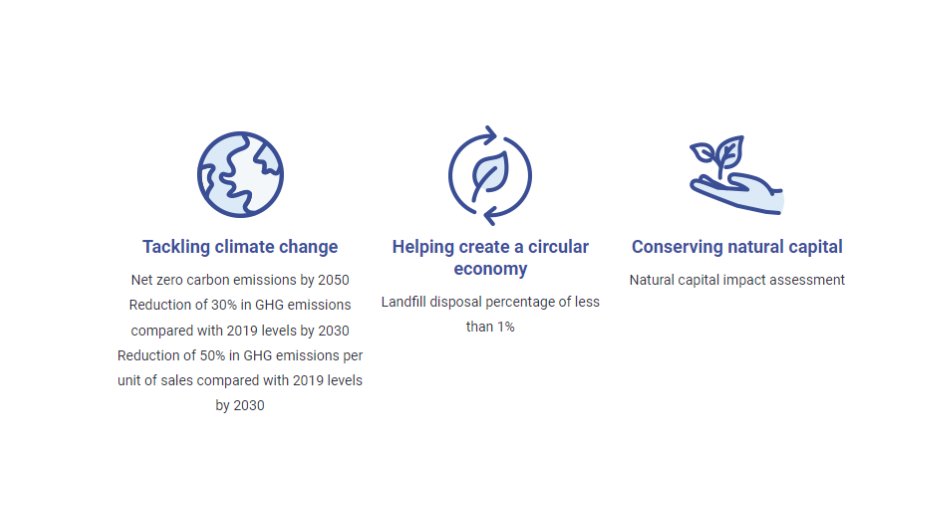
Resource circularity
The United Nations (UN) reported that there is a 50% chance of exceeding 1.5°C of global heating in the next five years. Between the UN Climate Summit of COP21 and COP26, the global economy consumed 70% more raw materials than the Earth can safely replenish. The planet thrives through circular, natural, and regenerative systems, which are being damaged by the impacts of an overwhelmingly linear built environment. Over one-third of the materials used worldwide are for buildings, but less than 9% of global materials consumed are circular (kept in productive cycles of use). Linear economies accelerate climate change and the decline of life-sustaining ecosystem services such as the maintenance of clean water and productive soils. Aware of this issue, AGC is building resource circulation loops at every phase of its business activities by rigorously implementing existing reduce, reuse, and recycle (3Rs) initiatives and by increasing resource productivity in all aspects of the operation.
Like climate action, AGC has set the ambitious target of zero waste emissions globally. This will be achieved by advancing waste recycling, reducing waste generation, and separating and collecting waste thoroughly (zero waste emissions are defined as a landfill disposal percentage that is less than 1.0% of the total volume of waste generated). To improve resource circularity, AGC has set targets for the utilisation percentages of recycled materials in its manufacturing process, reducing the need for virgin materials. The implementation involves each in-house company setting waste generation targets and conducting management based on annually set key performance indicators. The overall efforts are quantitatively measured through the resource productivity index which is calculated as the ratio of the volume of natural resources and energy used to the production amount and economic value generated therefrom. Some of these efforts are detailed below.
Use of Cullet (Refuse Glass)
During glass manufacturing processes, the generated glass wastes are called cullet which is commonly recycled as a raw material for asphalt. AGC has taken this one step further and reuses cullet in the glass manufacturing process as a substitute for raw materials such as silica sand. This measure reduces natural resource usage, diverts glass ends (cullet) destined for landfills and provides a circular end-of-life treatment for refuse glass from urban centres. In 2021, AGC Europe and Asia Pacific collectively recycled more than one million tonnes of cullet which translates to saving more than 1.3 million tonnes of raw materials and preventing more than 800,000 tonnes of CO2 emissions.
Conversion of cullet into artificial silica sand
Beyond preventing environmental degradation through reducing raw materials usage, recycled products can even directly contribute to ecosystem regeneration. The AGC Takasago Factory is helping regenerate tidal flats using artificial silica sand. Tidal flats are areas found on coastlines, shores of lagoons and estuaries. Sandwiched between marine, freshwater and land, these environments can support large numbers of shellfish and invertebrates such as mussels (with reported food provision 10-20 times higher than deeper coastal wasters) and serve as feeding grounds for migratory birds. Tidal flats have been decreasing over the years due to mismanagement and the built-up of coastal areas. One method of regeneration is the creation of artificial tidal flats, which can reduce the elution of nutrient salts from the seabed, supply oxygen that purifies water, and restore biodiversity. The use of recycled cullet for tidal flats demands physical properties equivalent to natural sand, with particular attention to smoothness and grain size. Cognizant of this, the Takasago factory mills the cullet silica sand to remove sharp edges, achieve conformity with tidal flats bottom sediments and maintain quality control through elution tests. This rigorous standard allows humans and wildlife to enjoy the ecosystem without injury.
Resource circularity using discarded sea urchin shells
AGC extends its circularity efforts beyond their products. Utilising existing expertise, AGC Group company Hokkaido Soda Co., Ltd. has commercialised a biological filter material recycled from sea urchin shells. The annual catch of sea urchins in Hokkaido is about 4,300 tons, but only about 15% is edible flesh. Despite being laborious and time-consuming to process the waste sea urchin shells, Hokkaido Soda has found a way to recycle and take advantage of the lightweight, porous structure of the shells, creating a highly adherent surface for bacteria. Aligned with AGC’s sustainability management, this filter material was developed in cooperation with the Fisheries Research Department of the Hokkaido Research Organisation, realising the creation of win-win social value creation. In recognition of the product’s circularity, it achieved the Hokkaido Certified Recycled Product in November 2019 and is commercially available since 2020.
Health and Wellbeing
There are few issues relating to human health, wellbeing and quality of life that are not impacted, directly or indirectly, by the attributes of our built Environment (The WorldGBC Health and Wellbeing Framework). US Environmental Protection Agency’s research showed that Americans on average spend 90% of their time indoors and the concentration of some pollutants in indoor environments can be 2-5 times higher than typical outdoor concentrations. While the research is dated and not applicable worldwide, the pandemic thrust the world into longer hours at home and pushed health and wellbeing to the forefront. Besides the direct impact on our physical and mental health, the built environment underpins our communities with buildings and the urban infrastructure that supports our daily lives – residence, education, parks, and entertainment. WorldGBC seeks to unlock the immense potential that the building and construction sector can have in improving human health and quality of life. This includes the people involved along all stages of the building lifecycle, from the health of construction workers to the environmental impacts of how we source materials, construct and operate our buildings.
The WorldGBC Health & Wellbeing Framework consists of six principles spanning indoor air quality, human rights in the supply chain, climate change resilience and more. Through a multi-year consultation involving consultation from the built environment, health and human rights groups, the framework demonstrates the cross-sectoral nature of catalysing social impact across the entire built environment value chain.
In May 2022, AGC joined the “30 by 30 Alliance for Biodiversity” in Japan. The “30 by 30” is a proposed international plan released at the G7 Summit held in 2021 to conserve and protect at least 30% of land and sea areas by 2030. The Alliance was established in April 2022 by the Ministry of the Environment as a voluntary coalition of companies, local governments, NPOs, and others. In addition to expanding Japan’s current protected areas, this initiative aims to register areas that have been conserved by the private sector and others as ‘Other Effective area-based Conservation Measure’ (OECM) in an international database to promote their conservation. This is a continuation of the Group’s involvement in biodiversity conservation and restoration through its past activities such as coral reef cultivation (Thailand and Indonesia), mangrove plantation (Indonesia), and protection of the endangered plant, the Golden orchid (Japan). Through its participation in the Alliance, the Group will make further efforts to conserve and restore biodiversity and contribute to the achievement of a nature-positive world.
In the AGC Group Charter of Corporate Behaviour, the AGC Group declares that it will “strive to be a trusted corporate citizen, fulfilling its responsibilities to the communities in which it does business.” To achieve this ideal and goal, three priority areas were established. The priority areas are (1) support for the next generation – which aims to support the development of children by helping them to live out their dreams since they will be the future, (2) harmony with local communities – which contributes to the sustainable development of local communities and (3) natural environment conservation – which contribute solutions to global environmental problems. Examples of these activities include AGC Vinythai Public Company Limited which started a coral cultivation project in 2003. The project’s phases 1 and 2 planted 90,000 coral plants in five locations in the Gulf of Thailand. As well as contributing to biodiversity in the Gulf, the project has also been well received by the local community for encouraging ecotourism and thereby supplementing the incomes of those living on the coasts. Since 2019, AGC Vinythai has been working on Phase 3, which involves extending the coastal areas covered by the project.
Look Beyond
Taking its pledge to achieve net zero carbon emissions by 2050 seriously, AGC has chosen the unambiguous key performance indicator of GHG emissions (Scope 1, 2 and 3) to evaluate its efforts. In this regard, AGC has demonstrated their resolve and innovation to successfully Reduce, Generate, Compensate and Plan its path to achieving net zero carbon. These efforts have been recognized as AGC clinches a spot in CDP’s 2022 “A-list” companies for ‘Climate Change’. CDP is an international non-profit organisation that uses a detailed, independent methodology to assess companies on the comprehensiveness of disclosure, awareness, management of environmental risks and demonstration of environmental leadership. Of nearly 15,000 companies scored, AGC is one of a handful of companies assessed to make a proactive effort in achieving meaningful and ambitious science-based targets. In achieving the A score, AGC demonstrated climate action best practices which are recognized by frameworks such as the Task Force on Climate-related Financial Disclosures (TCFD) and Accountability Framework. Beyond climate change, in realising AGC’s target of zero waste emissions globally the company has established targets and evaluation tools for all in-house companies. Firmly setting the direction and pushing ahead towards a circular economy. With AGC’s five social value creation model, the company is leading the industry towards a net-zero carbon, healthy, equitable and resilient built environment.
AGC’s sustainability journey
Sustainability is an evolving theme in management discussions. While some see it as an additional task on top of growth and profitability, pioneers in this field hold a different perspective. Rather than a strain on limited resources, growth and profitability are the natural results of internalising societal goals such as sustainable development and environmental protection. The path towards sustainability, however, is not naturally profitable.
The transition is challenging, gruelling even, and littered with failed transformations. With dire warnings from the Intergovernmental Panel on Climate Change (IPCC) 6th Assessment Report, embracing sustainability is a matter of companies’ and humanity’s survival. With tightening environmental regulations, the message that profitable companies in the future are also sustainable companies is clear. For an example of a company that has successfully transformed and continues to innovate and adapt, one needs to look no further than AGC.
Sustainable Development Goals (SDGs)
AGC has a strong history of being the frontrunner in benefitting society. In 2021, AGC established the Sustainability Committee which directly reports to the Board of Directors. A demonstration of clear commitment, with support from the highest echelons of the organisation, towards crafting policies for implementing and achieving sustainability targets. This is the continuation of a series of transformations since 2005, when the corporate social responsibility (CSR) committee was established, to accelerate Group-wide sustainability management and initiatives. These efforts reflect the choices AGC made to be a company that contributes significantly to a healthier global society, be a trusted corporate citizen and communicate responsibly with stakeholders. Such aspirations resonate with United Nations (UN) Sustainable Development Goals (SDGs) which are a call to action for global partnerships to realise peace and prosperity for people and the planet, now and into the future. To that end, the AGC Sustainability Division works in generating social value related to the SDGs.

The commitment to sustainability suggests a culture that is not satisfied with ‘just enough’ but seeks to push boundaries to benefit the customers and society. This is well encapsulated in the Group’s brand statement “Your Dreams, Our Challenge”, where AGC aims to ‘help make even greater achievements possible, and bring bolder ideas to life” and they are doing it. Through the products, technologies and corporate activities, AGC has been generating positive changes relating to the majority of the 17 SDGs. For example, by using supplier selection based on human rights and environmental protection requirements, AGC has made the world a better place by contributing to reduced inequalities and responsible consumption & production. Similar corporate governance and social value generating activities are embedded throughout AGC’s wide spectrum of businesses from the built environment, mobility, and pharmaceuticals To understand how the unique culture of innovation and sustainability took hold, we need a trip into the past.
A peek into the past
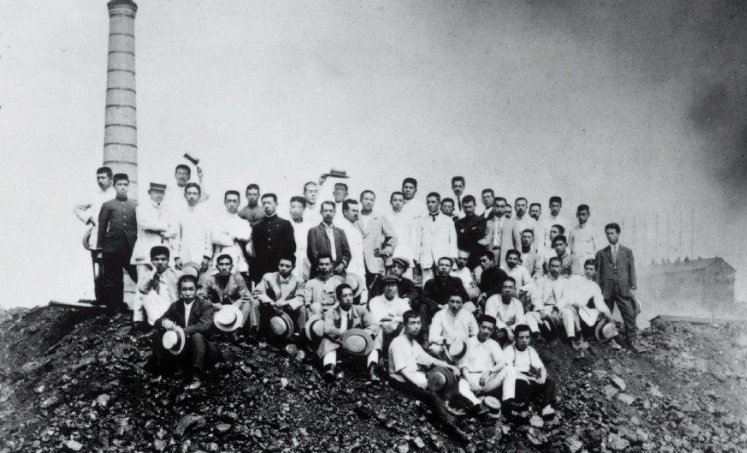
“There are not many Japanese companies that have been in business for over 100 years and continued to create new businesses. It is also rare for the management team to be leading the way.” AGC seems to have a knack for innovation and it has been dubbed the “DNA to tackle challenges”. Diving into the company’s origins, a mere 7 years after its founding in 1907, it faced supply chain disruptions due to World War I and was unable to import raw materials and kiln bricks for glass manufacturing. In overcoming this challenge through developing some of the raw material supply businesses in-house (for example, as Japan’s first soda ash producer), it propelled AGC into adjacent industries of chemicals and ceramics. Fast forward a century later, these 2 businesses have evolved and contributed about 42 percent of total net sales for FY 2021.
The spirit of continuous innovation was seen again in 2010 when AGC recorded its highest profits thanks to glass substrates for the Display business. Despite the profits, the then management harboured a cautious sense of crisis. Dr Hirai (now AGC Group CEO) was appointed as the 1st head of the business development office to develop new businesses that can reduce the reliance on Display business. “In the materials industry, it is normal for it to take 10 to 20 years from the start of R&D to commercialisation. That is why we keep thinking about what to do next before one business reaches its peak,” said Dr Hirai. The foresight has paid off in recent years as AGC’s biotechnology and contract pharmaceutical business boomed amidst the COVID 19 pandemic.
Climate action
This characteristic of considering longer horizons results in AGC identifying ‘Environment’ as one of 4 shared values (others being ‘Innovation & Operational Excellence’, ‘Diversity’ and ‘Integrity’). This shared value manifested in AGC in the form of the target to achieve net-zero carbon emissions by 2050. A truly ambitious task, considering that the manufacturing of glass is an energy-intensive industry, amongst other challenges. As part of the decarbonisation effort and behaving with the rigours of a sovereign state, AGC has introduced internal carbon pricing (ICP) to drive low-carbon investment. When making investment decisions, ICP is used to evaluate the profitability of projects by taking future carbon costs into account. The effect is reduced dependence on fuel combustion in glass melting facilities through electrification. The melting is made cleaner through the conversion to gas/oxygen combustion instead of oil combustion. In terms of carbon efficiency, the conversion of heavy oils to natural gas reduces about 20% of CO2 emissions during combustion. However, the drive toward net-zero carbon emissions does not end there as AGC engages in ongoing research efforts such as carbon-free ammonia combustion. Their other efforts recognise the necessity of resource circularity in reducing carbon footprint. When it comes to raw materials for glass manufacturing, AGC uses glass cullet (refuse glass) as a substitute for raw materials such as silica sand. This reduces the environmental degradation associated with natural resource extraction and reduces waste in landfills through the recycling of urban construction waste.
The net-zero carbon emissions target by 2050 takes into account Greenhouse Gases (GHG) directly emitted by AGC owned/controlled sources and indirect emissions from the generation of purchased electricity, steam, heating and cooling consumed by AGC. This is no mean feat for a global materials manufacturer of glass, chemicals and electronics industry. Beyond the company’s operations, AGC’s carbon reduction efforts can help to reduce other companies’ GHG emissions. This has not gone unnoticed as AGC received the 2022 Supplier Award from Honda Motor in the Sustainability Category, a recognition for their efforts which allow carbon reduction to propagate through the supply chain, benefitting even the final consumer.
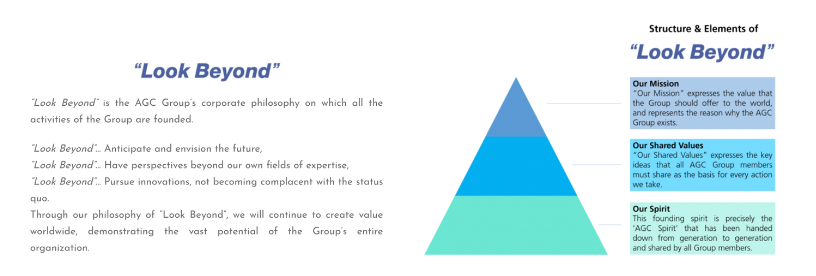
AGC Group Vision – “Look Beyond”
The vision captures the company’s philosophy to “anticipate and envision the future”, “to have perspectives beyond our fields of expertise” and “to pursue innovations, not becoming complacent with the status quo”. This vision is guided by management policies such as “Building a better future for the coming generations” and applied in its Asia Pacific regional headquarter AGC Asia Pacific Pte. Ltd. (AAP). Following one of the company’s founding spirits “A sense of mission leads us to advance”, AAP consistently engages and shares knowledge with built environment stakeholders in the region. The partnership between AAP, regional green building councils, and other stakeholders culminated in AAP becoming one of the Founding Partners of the World Green Building Council (WorldGBC) Asia Pacific Regional Network (APN) in 2017.
This partnership aligns with WorldGBC’s emphasis that collaboration between the private and public sectors is critical in catalysing sustainable built environments for everyone, everywhere. The need for collaboration can be seen in the Net Zero Carbon Buildings Commitment, which garnered 129 signatories across 28 cities worldwide, and the Beyond the Business Case report 2021, which demonstrated irrefutably the co-benefits of investing in a sustainable built environment in the financial and social value cases. However, the situation today is vastly different from the early 2010s. The Asia Pacific region contains 16 of the world’s 28 mega-cities (cities with a population of 10 million and above), spans 11 time zones and has climates ranging from temperate to tropical. Adding to the complexity is the different economic development status, government regulations and culture. The gap between countries was wide. While countries more advanced in green buildings were tackling technicalities of energy efficiency, some others lack the awareness and thus did not even emphasize sustainability in the built environment.
Before 2017, the role of the APN Regional Manager was performed by a built environment practitioner on a rotation and part-time basis. The stakeholders recognise that the sharing of knowledge and best practices is essential for the capability development of the whole industry. Thus, it becomes apparent that the requirements to engage and collaborate with 15 regional green building councils (GBCs) and build awareness and capability exceed that of an APN Regional Manager’s part-time role. After the 2016 WorldGBC APN meeting, there was a consistent collective voice among regional GBCs to invite partners to organise, coordinate and support APN activities and business cases. With the strong build material expertise, corporate sustainable vision and governance, AGC was a natural choice. Echoing the vision to ‘Look Beyond’, AAP gladly accepted the challenge to collaborate and help realise the positive benefits of green building.
Walking the talk
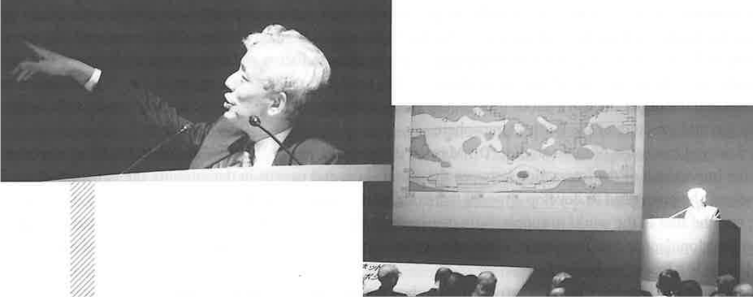
How was AGC able to readily take the leap in 2017? In 1992, the Asahi Glass Foundation, which was established in 1933 to commemorate the twenty-fifth anniversary (1932) of the founding of AGC, established the Blue Planet Prize. The award is presented annually to individuals or organizations worldwide in recognition of outstanding achievements in scientific research and its application that have helped provide solutions to global environmental problems. The award’s name was inspired by the remark “the Earth is blue,” uttered by the first human in space, Russian cosmonaut Yuri Gagarin, upon viewing our planet. The Blue Planet Prize was so named in the hope that the award can encourage efforts in healing Earth’s environment so that our blue planet, this shared asset of ours, can sustain human life far into the future. It speaks volumes about the Asahi Glass Foundation’s foresight in sustainability as the Blue Planet Prize’s inaugural winner (in 1992), Dr Syukuro Manabe, was awarded The Nobel Prize in Physics 2021 for “the physical modelling of Earth’s climate, quantifying variability and reliably predicting global warming”.
It is not just what AGC does that breathes sustainability but also the impact of its products. In Singapore, AGC is the first glass manufacturer to have its products certified under the Singapore Green Building Product (SGBP) labelling scheme. To date, its product continues to hold the highest level of product certification in the market, a testimony to its ability to achieve architectural needs while achieving energy-saving requirements. This has long-lasting effects as the CO2 emitted at the time of manufacturing is offset 10 folds due to the products’ contribution to CO2 emissions reduction throughout its lifetime in urban built environments. AAP’s various technologies and commitment to helping the world achieve a more sustainable environment were recognised with the Singapore Green Building Council (SGBC) – Building and Construction Authority (BCA) Leadership in Sustainability Awards in 2018. Through the years, AAP has never stopped offering its expertise and assistance in eco-friendly materials.
Never one to keep innovations with social value to themselves, over the years AGC shared their continuous efforts in energy efficiency and achieving zero energy building at various Green Building Congresses and seminars. Their experience comes from the strong research development and the construction of the administrative building of the Kashima Plant (Kamisu, Ibaraki Prefecture) with a net-zero energy certification and the AGC Glass Europe headquarters building with a nearly zero-energy categorisation. In the Kashima Plant, the front façade utilised glass that combined heat insulation effects and photovoltaic modules, achieving air conditioning energy consumption reduction and renewable energy generation. With the knowledge gained from products and materials that made Zero-Energy Buildings (ZEB) possible, AGC shared it amongst the built environment stakeholders through their involvement in the APN Technical Task Force, contributing to the Embodied Carbon Primer Report and Net Zero Readiness Framework.
Not taking the easy way out
Sustainability has come a long way and though the focus might have shifted over the years, from environment protection to tackling climate change, what stayed constant is that sustainable efforts are never easy and it takes strong partnerships to advance the industry together. The founding spirit of Mr Toshiya Iwasaki who established the company in 1907 is “Never take the easy way out, but confront difficulties”. This remains ‘the AGC spirit’ that has been handed down from one generation to the next. At AGC, breathing the spirit of not taking the easy way out, the organisation gladly took on the responsibility to improve internally and innovate new solutions and products to continue to deliver excellence in sustainability and beyond.
